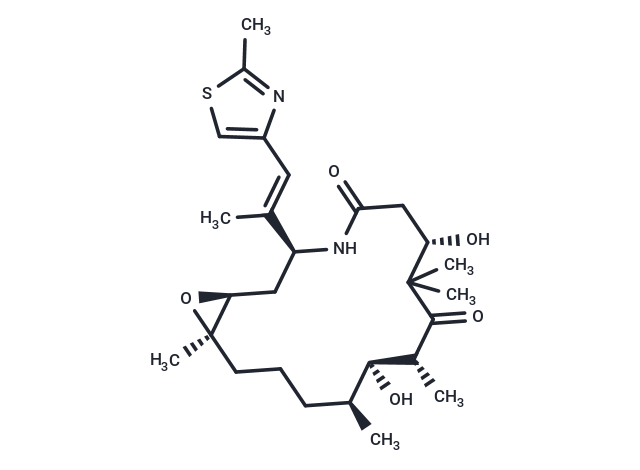Shopping Cart
- Remove All
 Your shopping cart is currently empty
Your shopping cart is currently empty

Ixabepilone (Azaepothilone B) is an orally bioavailable microtubule inhibitor. It binds to tubulin and promotes tubulin polymerization and microtubule stabilization, thereby arresting cells in the G2-M phase of the cell cycle and inducing tumor cell apoptosis.

| Pack Size | Price | Availability | Quantity |
|---|---|---|---|
| 1 mg | $52 | In Stock | |
| 2 mg | $94 | In Stock | |
| 5 mg | $198 | In Stock | |
| 10 mg | $363 | In Stock | |
| 25 mg | $590 | In Stock | |
| 50 mg | $857 | In Stock | |
| 100 mg | $1,150 | In Stock | |
| 200 mg | $1,550 | In Stock | |
| 1 mL x 10 mM (in DMSO) | $229 | In Stock |
| Description | Ixabepilone (Azaepothilone B) is an orally bioavailable microtubule inhibitor. It binds to tubulin and promotes tubulin polymerization and microtubule stabilization, thereby arresting cells in the G2-M phase of the cell cycle and inducing tumor cell apoptosis. |
| In vitro | BMS-247550 is an extremely effective cytotoxic compound that eradicates cancer cells at low nanomolar concentrations. It also preserves its antineoplastic efficacy in human cancers that are either inherently resistant to paclitaxel or have acquired paclitaxel resistance[1]. |
| In vivo | In vivo, BMS-247550 has clearly demonstrated antitumor activity that is superior to paclitaxel in both paclitaxel-resistant and -sensitive tumors. BMS-247550 is more efficacious compared to paclitaxel in all five paclitaxel-resistant tumors evaluated in this study (four human and one murine): i.e., the clinically derived paclitaxel resistant Pat-7 ovarian carcinoma, the A2780Tax ovarian carcinoma that is resistant to paclitaxel because of tubulin mutations, the HCT116/VM46 MDR colon carcinoma, the clinically derived paclitaxel-resistant Pat-21 breast carcinoma, and the murine fibrosarcoma M5076. Against three paclitaxel-sensitive human tumor xenografts, BMS-247550 produces antitumor activity equivalent to paclitaxel: i.e., A2780 human ovarian carcinoma, HCT116, and LS174T human colon carcinoma[1]. |
| Kinase Assay | The potency with which BMS-247550 and paclitaxel polymerize tubulin isolated from calf brain is evaluated by Published techniques. Briefly, different concentrations of paclitaxel or BMS-247550 in polymerization buffer [0.1?M mes, 1 mM?EGTA, 0.5 mM?MgCl2 (pH 6.6)] are added to tubulin in polymerization buffer at 37°C in microcuvette wells of a Beckman. Model DU 7400 UV spectrophotometer. A final microtubule protein concentration of 1.0 mg/mL and compound concentrations of generally 2.5, 5.0, and 10 μM?are used. Initial slopes of absorbance (A280 nM) change, measured every 10 s, are calculated by the software program accompanying the instrument. |
| Cell Research | HCT116 cells from cultures are collected by trypsinization after 1, 2, 4, 8, 16, and 24 h exposure to 7.5 nm of BMS-247550. Cells are pelleted and fixed in 80% ethanol at −20°C. After an overnight storage at −20°C, cells are rehydrated with PBS buffer and DNA stain by incubation with propidium iodide (5 μg/ml) in 0.1% RNase for 15–30 min. Fluorescence-activated cell sorter acquisition is performed using the FACS Calibur instrument and analysis is done using Cellquest and Modfit software. (Only for Reference) |
| Alias | Ixempra, BMS 247550-1, BMS 247550, Azaepothilone B |
| Molecular Weight | 506.7 |
| Formula | C27H42N2O5S |
| Cas No. | 219989-84-1 |
| Smiles | C[C@H]1CCC[C@@]2(C)O[C@H]2C[C@H](NC(=O)C[C@H](O)C(C)(C)C(=O)[C@H](C)[C@H]1O)C(\C)=C\c1csc(C)n1 |
| Relative Density. | 1.122g/cm3 |
| Storage | Powder: -20°C for 3 years | In solvent: -80°C for 1 year | Shipping with blue ice. | |||||||||||||||||||||||||||||||||||
| Solubility Information | Ethanol: 93 mg/mL (183.5 mM) H2O: < 1 mg/mL (insoluble or slightly soluble) DMSO: 93 mg/mL (183.5 mM) | |||||||||||||||||||||||||||||||||||
Solution Preparation Table | ||||||||||||||||||||||||||||||||||||
Ethanol/DMSO
| ||||||||||||||||||||||||||||||||||||

Copyright © 2015-2024 TargetMol Chemicals Inc. All Rights Reserved.